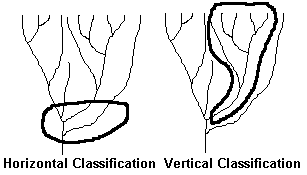All we will do here is introduce some of the basic ideas in systematics, which we can define as "the scientific study of the kinds and diversity of organisms and of any and all relationships among them" (Simpson 1961).
If we are to work with relationships, we must also have some type of classification system to display such relationships. This is the role of taxonomy, and that also will be considered here. The legalistics of taxonomy fall under the heading of nomenclature ("naming").
"Relationship" is a broad term capable of being applied to any of a number of concepts. Some concepts of relationship are useful, some are not. Consider, for example, the librarian whose idea of relationship is focused on the color of the book binding: all red-bound books are shelved together, all yellow-bound books, etc. Such books are arranged by their relationships of binding color—but such a relationship is useless for anyone trying to locate a book by a given author or about a given subject.
We also may note that different relationships can legitimately be emphasized, depending on purpose. In biology, we often classify things by energy relationships (e.g., producers, consumers, decomposers), by ecological relationships (e.g., aquatic, terrestrial, volar), chemical characteristics (e.g., gram-positive, gram-negative). These are special classifications for special purposes. A major question of systematists is, What system has the greatest general utility? This is the question that has both divided systematists for the last 4 decades or so and, at the same time, has resulted in a flowering of the field.
There are three major scientific philosophies of relationships among organisms: phenetics (often known as numerical taxonomy), cladistics (phylogenetic classification), and evolutionary (or classic). Each has its strengths and weaknesses.
Phenetics is based on overall similarity (in morphology in a broad sense—to include physiology, behavior, etc.). A large number of characters is utilized (usually a minimum of 30). By utilization of numerical clustering techniques and distance measures in morphological hyperspace, taxa are arranged by overall similarity. The basic philosophy is that a classification by phenetics tells you more about the organisms classified than classifications based on evolutionary relationships or other criteria—thus it is the most widely usable form of classification. It also has been an attempt to erect an objective system where anyone working with the same dataset would end up with the same classification (unfortunately, the field has never stabilized to the point where this has come about). Although still of some prominence in botany, phenetics is little used today in zoology, having been outcompeted by cladistics.
Cladistics generally is considered the wave of the future (or even of the present). Unlike phenetics, where the sole criterion is similarity, the only criterion for cladistics is phylogenetic relationship—similar to the "begats" of the Bible. That is, who gave rise evolutionarily to whom and in what order in regards to other relatives.
Because cladistics is so prominent in biology today (and to keep any one set of web pages limited in length), a separate section is devoted to it.
Return to this page after digesting cladistics.
Evolutionary classification applies a blend of similarity and relationship. To take an example of the lobe-finned fishes which we visited in the section on cladistics, traditional evolutionary classification places them in the same taxon as the ray-finned fishes (Osteichthyes) because of the numerous similarities between the two groups (that is, the two groups have not diverged greatly from their common ancestor). In this case, horizontal classification is being practiced, whereas cladistics places them in different high-level taxa with the lobe-finned fishes in the same taxon as the tetrapods rather than with the ray-finned fishes.
However, in other cases in evolutionary classification, as with the Family Equidae, vertical classification has been followed, with the entire monophyletic group originating with the first recognizable member of the horse lineage being classified in that family; that first member of the family, however, is much more similar to early members of the tapir and rhinoceros groups than to recent equids. Many parts of the classification are intermediate to the examples, combining elements of horizontal and vertical classification.

In the horizontal classification, the four taxa encircled would be placed in a single larger taxon; likewise, in a vertical classification, all members of the encircled phylogenetic line would be place in the same larger taxon.
In general, such decisions have been made on the basis of what the classifier was studying or wished to emphasize. Although long found useful, the critics have an important point: there is no a priori way of knowing what criteria have been used in a particular case—familiarity with that part of the classification is necessary.
Not only an understanding of systematics, but also of nomenclature is required of the student.
Last Update: 11 Jan 2008
Centennial Museum and Department of Biological Sciences, The University of Texas at El Paso